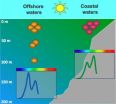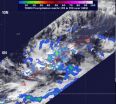(Press-News.org) Call it "PAC-MAN, the Sequel." Scientists with NASA's Cassini mission have spotted a second feature shaped like the 1980s video game icon in the Saturn system, this time on the moon Tethys.
The pattern appears in thermal data obtained by Cassini's composite infrared spectrometer, with warmer areas making up the PAC-MAN shape.
"Finding a second PAC-MAN in the Saturn system tells us that the processes creating these 'PAC-MEN' are more widespread than previously thought," said Dr. Carly Howett, the lead author of a recently published paper in the journal Icarus. "The Saturn system — and even the Jupiter system — could turn out to be a veritable arcade of these characters," said Dr. Howett, research scientist in the Planetary Science Directorate of SwRI's Space Science and Engineering Division. The article, "PAC-MAN Returns: An Electron-Generated Thermal Anomaly on Tethys," by C.J.A. Howett, J.R. Spencer, T. Hurford, A. Verbiscer and M. Segura, can be seen at http://www.sciencedirect.com/science/article/pii/S0019103512004204?v=s5, doi: 10.1016/j.icarus.2012.10.013.
Scientists saw the first PAC-MAN thermal shape on the Saturnian moon Mimas in early 2010. They theorized that the shape occurs because high-energy electrons bombard the side of the moon that faces forward as it orbits around Saturn.
As a result the altered surface does not heat as rapidly in the sunshine or cool down as quickly at night as the rest of the surface, similar to how a boardwalk feels cooler during the day but warmer at night than the nearby sand.
"Studies at infrared wavelengths give us a tremendous amount of information about the processes that shape planets and moons," said Mike Flasar, the spectrometer's principal investigator at NASA's Goddard Space Flight Center in Greenbelt, Md. "A result like this underscores just how powerful these observations are."
Finding another PAC-MAN not only confirms that high-energy electrons can dramatically alter the surface of an icy satellite, but it also shows that this alteration is dramatic enough that it is not cancelled out by the icy particles in Saturn's "E Ring" that continually blanket that part of the moon's surface.
Scientists saw the new PAC-MAN on Tethys in data obtained on Sept. 14, 2011. The warmest temperature recorded was a chilly minus 300 degrees Fahrenheit (90 Kelvin), which is actually slightly cooler than the warmest temperature at Mimas (about minus 290 degrees Fahrenheit or 95 kelvin).
At Tethys, unlike Mimas, the pattern can also be subtly seen in visible-light images of the surface as a dark, lens-shaped region. This coloration variation was first noticed in a 1980 image of Tethys obtained by NASA's Voyager spacecraft.
"Finding a new PAC-MAN demonstrates the diversity of processes at work in the Saturn system," said Linda Spilker, Cassini project scientist at NASA's Jet Propulsion Laboratory, Pasadena, Calif. "Future Cassini observations may reveal other new phenomena that will surprise us and help us better understand the evolution of moons in the Saturn system and beyond."
INFORMATION:
The Cassini-Huygens mission is a cooperative project of NASA, the European Space Agency and the Italian Space Agency. The Jet Propulsion Laboratory, a division of the California Institute of Technology in Pasadena, manages the Cassini-Huygens mission for NASA's Science Mission Directorate, Washington. The Cassini orbiter was designed, developed and assembled at JPL. The CIRS team is based at NASA's Goddard Spaceflight Center in Greenbelt, Md., where the instrument was built.
END
An international team of biologists led by Indiana University's David M. Kehoe has identified both the enzyme and molecular mechanism critical for controlling a chameleon-like process that allows one of the world's most abundant ocean phytoplankton, once known as blue-green algae, to maximize light harvesting for photosynthesis.
Responsible for contributing about 20 percent of the total oxygen production on the planet, the cyanobacteria Synechococcus uses its own unique form of a sophisticated response called chromatic acclimation to fine tune the absorption properties ...
Implementation of the Affordable Care Act – now assured by the re-election of President Obama – is expected to result in up to 50 million currently uninsured Americans acquiring some type of health insurance coverage. But a study by researchers at the Mongan Institute for Health Policy at Massachusetts General Hospital (MGH) finds that a significant percentage of the primary care physicians most likely to care for newly insured patients may be not be accepting new patients. The investigators note that strategies designed to increase and support these "safety-net" physicians ...
Shedding light on the limits of life in extreme environments, scientists have discovered abundant and diverse metabolically active bacteria in the brine of an Antarctic lake sealed under more than 65 feet of ice.
The finding, described in this week's issue of the Proceedings of the National Academy of Sciences, is surprising because previous studies indicate that the brine has been isolated from the surface environment -- and external sources of energy -- for at least 2,800 years, according to two of the report's authors, Peter Doran and Fabien Kenig, both professors ...
You could call this "Pac-Man, the Sequel." Scientists with NASA's Cassini mission have spotted a second feature shaped like the 1980s video game icon in the Saturn system, this time on the moon Tethys. (The first was found on Mimas in 2010). The pattern appears in thermal data obtained by Cassini's composite infrared spectrometer, with warmer areas making up the Pac-Man shape.
"Finding a second Pac-Man in the Saturn system tells us that the processes creating these Pac-Men are more widespread than previously thought," said Carly Howett, the lead author of a paper recently ...
The twenty-sixth tropical cyclone of the western North Pacific Ocean season formed and has some areas of heavy rain, according to data from NASA's TRMM satellite. Tropical Depression 26W is threatening islands within Micronesia and warnings and watches are currently in effect.
Micronesia is a region in the western North Pacific Ocean made up of thousands of small islands. West of the region is the Philippines, while Indonesia is located to the southwest.
NASA's Tropical Rainfall Measuring Mission (TRMM) satellite passed over Tropical Depression 26W on Nov. 26 at 0526 ...
CHICAGO – The radiation dose to areas of the body near the breast during mammography is negligible, or very low, and does not result in an increased risk of cancer, according to a study presented today at the annual meeting of the Radiological Society of North America (RSNA). The results suggest that the use of thyroid shields during mammography is unnecessary.
"Thyroid shields can impede good mammographic quality and, therefore, are not recommended during mammography," said Alison L. Chetlen, D.O., assistant professor of radiology at Penn State Hershey Medical Center.
During ...
CHICAGO – Radiologists in Toronto have begun to identify a pattern of injuries that may be indicative of elder abuse, according to a study presented today at the annual meeting of the Radiological Society of North America (RSNA).
According to lead researcher Kieran J. Murphy, M.D., F.R.C.P.C., F.S.I.R., interim radiologist-in-chief at University Health Network in Toronto, Canada, only 2 percent of physical elder abuse is reported by clinicians.
"Unlike cases of child abuse, there is very little information available on this subject," Dr. Murphy said. "It's a much ...
CHICAGO – Researchers reviewing the records of approximately 250,000 women enrolled in an integrated healthcare delivery system found that increased CT utilization between 2000 and 2010 could result in an increase in the risk of breast cancer for certain women, including younger patients and those who received repeat exams. According to the study, which was presented today at the annual meeting of the Radiological Society of North America (RSNA), nuclear medicine examinations may also contribute to increased breast cancer risk.
CT uses ionizing radiation in the form ...
CHICAGO – A survey of women undergoing routine screening mammography found that many of them would be interested in pursuing additional screening tests if notified they had dense breast tissue, despite the possibility of false positives, invasive procedures, and out-of-pocket costs, according to a study presented today at the annual meeting of the Radiological Society of North America (RSNA).
"Our study highlights the need for patient education regarding breast density," said Jafi Lipson, M.D., assistant professor of radiology at Stanford University School of Medicine ...
CHICAGO – Researchers assessing the impact of revised guidelines for screening mammography issued by the U.S. Preventive Services Task Force (USPSTF) found evidence that the new recommendations may lead to missed cancers and a decline in screening, according to two studies presented today at the annual meeting of the Radiological Society of North America (RSNA).
Routine screening mammography has traditionally been recommended by both the USPSTF and the American Cancer Society for all women over the age of 40. In 2009, the USPSTF issued controversial new guidelines recommending ...

